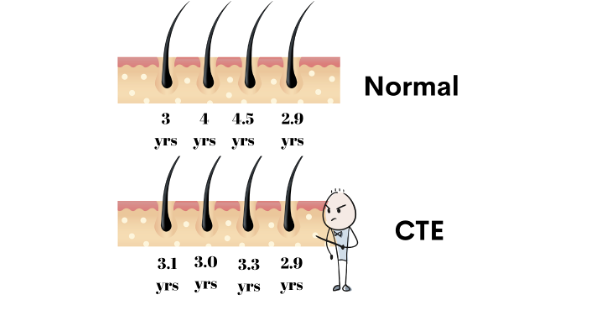Chronic Telogen Effluvium: Stricter Rules on Length of Anagen
Reduction in Flexibility on Anagen Length May Underlie this Chronic Shedding Disorder
Chronic telogen effluvium is a frustrating scalp condition for patients. Patients have cycles of significant degrees of hair shedding followed by periods of much less hair shedding. During the times of high shedding, patients often try many treatments in order to reduce the shedding. What often happens soon thereafter - is a reduction in shedding. The reduction in shedding is often not due to the efforts of the patient - but rather the natural course of the condition. Patients are convinced that what they did was responsible for the reduction in shedding. Unfortunately, hopes are diminished when hair shedding starts up again some time later.
New Study Suggests CTE Happens Due to Stricter Rules on What is Deemed an Acceptable Anagen Phase Length
The anagen phase on the human scalp is normally 1-7 years. Some hairs have an anagen phase of 1 year, some hairs have an anagen phase of 2 years and some have 3,4,5,6 and 7 years. Normally, there is quite a variation in acceptable duration of anagen phases.
Gilmore S and Sinclair R. 2010
In a fascinating study from 2010, authors used computer modeling to relax and tighten the acceptable range of anagen lengths. For the normal scalp model they programmed the model with 16 months for anagen, 1.6 months for telogen, and 4 months for a resting phase. They programmed a 2 months variance on either side for all these phases.
When the authors reduced the average length of anagen from 16 months to 10 months but allowed hairs to have a flexible range of really short, medium short, medium long and long duration (“choose a wide variety of durations you want on either side of 10 months”) - the result was an increase in shedding slightly followed by pretty constant shedding at a new higher levels as well as a reduction in density on the scalp. This mimicked androgenetic alopecia pretty well!
In contrast, when the authors kept the duration of anagen fixed at 16 months but reduced the acceptable variation on either side of 16 months to 1.05 months instead of 2 months (ie DID NOT allow hairs to have a flexible range of anagen duration - “choose what length you want within a much smaller window on either side of 16 months”) -- the result was an increase in shedding slightly followed by intensely fluctuating periods of shedding at a new higher level followed by some degree of improvement. There were reductions in density followed by increases in density followed by reductions in density followed by increases in density. But what was interesting in the modeling was that over a long period of time, density was found to settle out at pretty close to what it was at the beginning (just slightly below but not much). Shedding continued slightly above the normal level but there were no more of the dramatic shedding and recovery phases that characterized the early periods.
This mimicked chronic telogen effluvium pretty well!
Conclusion
All in all, the authors propose that CTE may be due to a reduction in the variance of anagen phases length. In other words, there is a much tighter control over what is an acceptable length of anagen phase.
We don’t know why this happens yet!
REFERENCE
Gilmore S and Sinclair R. Chronic telogen effluvium is due to a reduction in the variance of anagen duration. Australas J Dermatol. 2010 Aug;51(3):163-7.
This article was written by Dr. Jeff Donovan, a Canadian and US board certified dermatologist specializing exclusively in hair loss.


